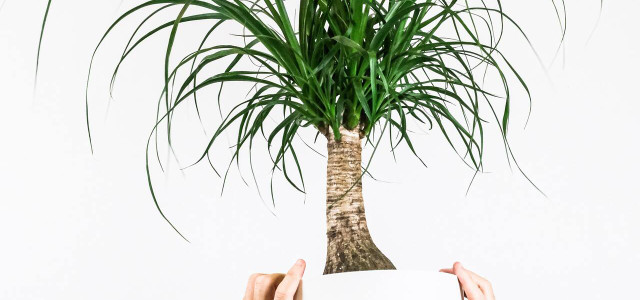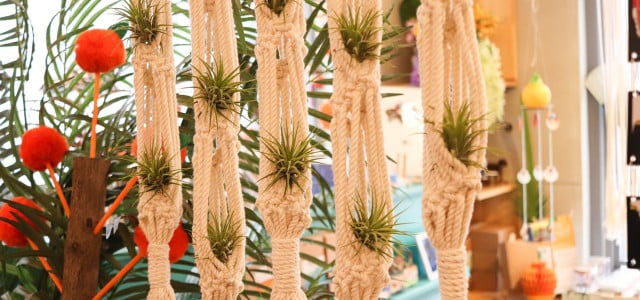The ponytail palm has become a much-loved houseplant by many, and it is important to take good care of it. We’ve compiled the best ponytail palm care tips for you below.
The ponytail palm, also called elephant’s foot (Beaucarnea recurvata), is a member of the Asparagaceae family — and in reality not closely related to real palm trees. It gets its name from the stem that grows wider towards the bottom, much like an elephant’s foot, or alternatively from its long thin leaves that grow up- and outwards from the stem, like hair in a tight ponytail.
In general, the ponytail palm is also one of the easiest houseplants to take care of. This is because it is very low maintenance and requires very little care, as it thrives in drier conditions and doesn’t need much watering. So, unless you’re doing something really wrong, you shouldn’t have to worry too much about your Ponytail Palm.
As they are native to a hot climate, the ponytail palm is used to surviving in dry and hot conditions. We’ve compiled a list of ponytail palm care tips so you can accommodate your new houseplant accordingly.
Caring for Your Ponytail Palm: Does it Bloom?
The ponytail palm is a species of plant in the Asparagaceae family — a family of flowering plants. However, flowering can often take up to as long as thirty years, and usually, the plants have to be in the correct conditions outdoors.
These conditions include:
- A lot of heat
- Sunshine
- The correct humidity
Due to these factors, it is very unlikely you will see your ponytail palm flower when kept in household conditions. However, it is not impossible. If you have the patience to wait at least ten years and provide the plant with suitable conditions, you might see it bloom.
A telltale sign that your ponytail palm is about to bloom is that you will see flower spikes begin to appear around the plant. These flowers will eventually bloom to be either ivory or pink, depending on the gender of your plant. If it is a male you will see ivory flowers; if it is a female you will see the pink flowers.
Ponytail Palm Care Tips
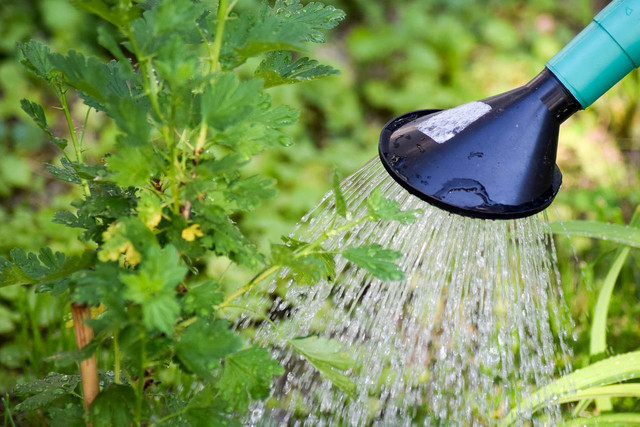
(Foto: CC0 / Pixabay / annawaldl)
Taking good care of your ponytail palm is essential to help it thrive in household conditions, especially since the plant is native to a more tropical climate. The following tips will help you to give it that extra care and attention that it needs.
Here is what we recommend:
- Plenty of sunlight: Ponytail palms need access to a lot of light, so it is best to place them in a bright location with indirect sunlight. There are also houseplants that can thrive in darker conditions. These could suit other areas of your house if you are looking to build up your plant collection. However, darker conditions are not suitable for the ponytail palm.
- Soil: The soil needs to be kept fairly dry and it needs to try out significantly between each watering.
- Water occasionally: Your ponytail palm only needs to be watered occasionally — around every two to three weeks. However, check the soil first to make sure it’s dry enough. It is important not to overwater your plant, as this can cause stem rot. Warning signs of stem rot include yellowing leaves and a soft and squishy stem.
- Fertilization: Fertilize your ponytail palm two to three times a year, preferably in the spring with a cacti/succulent fertilizer. Be careful not to fertilize your plant any more than this as it may develop brown tips on its leaves.
- Temperature: Room temperature is best for this houseplant. However, in winter you should keep the plant slightly cooler between 50-55°F. This helps the plant by replicating its natural dormancy cycle.
- Pot: When choosing a pot for your ponytail palm, you will need to make sure there are enough drainage holes. This is essential for the health of your houseplant. Ideally, the pot should be around two inches wide around the base of your plant.
Watering tips:
- Water from spring till fall.
- Only water occasionally during winter.
- Wait for the top two inches of soil to dry completely before watering again.
- Place a dish under your plant and allow any excess water to drain through.
- Discard any remaining water in the dish after a several minutes.
The ponytail palm is safe and non-toxic to cats and dogs, according to the ASPCA. Therefore, there is no need to worry if you have any furry friends lurking around your home.
Ponytail Palm Care: Common Pests
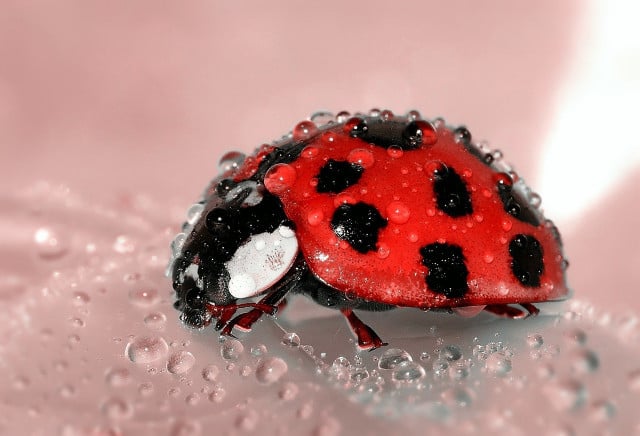


(Foto: CC0 / Pixabay / cocoparisienne)
Although pests are annoying to deal with, it is better to be well prepared so you can deal with them adequately if they decide to attack your plant. Here are some of the most common pests of the ponytail palm:
- Spider mites
- Mealybugs
- Aphids
- Thrips
- Scale insects
- Other leaf chewing insects
You should remove any visibly infected leaves and separate them from any other houseplants you may have, otherwise you may risk cross-contamination among your plants.
How to deal with common pests:
- Spider mites: To counter spider mites, you can rub a cloth of dish soap and water on the stems of your Ponytail Palm. You can also directly dab pests with a cotton swab containing 70 percent isopropyl alcohol, which should help to control the problem. Dill is one of the plants that repel insects like spider mites and aphids.
- Mealybugs: Find a pesticide that contains pyrethrin and is labeled to work against mealybugs. Pyrethrin can also work well against other pests when mixed with other ingredients.
There are also more natural alternatives that can help you to remove common pests. You can use natural predators such as lacewings and ladybugs, both of which prey on common plant pests. This is a great natural solution as these insects won’t harm or damage your ponytail palm.
It is important to remember to avoid applying treatments to your ponytail palm in the heat of the sun, as it can dry the leaves out quickly. You should also test using soap and water on a small section of the plant beforehand, to ensure there are no sensitivity issues.
Are ponytail palms insect friendly?
Ponytail palms will tolerate lacewings and ladybugs as mentioned earlier. Once maturity is reached and the flowers bloom, airborne pollinators can be attracted to the plant.
However, it is not very likely that your plant will bloom unless it meets the conditions stated earlier — such as high heat and a ten-year wait period.
Things to Look out for With Your Ponytail Palm
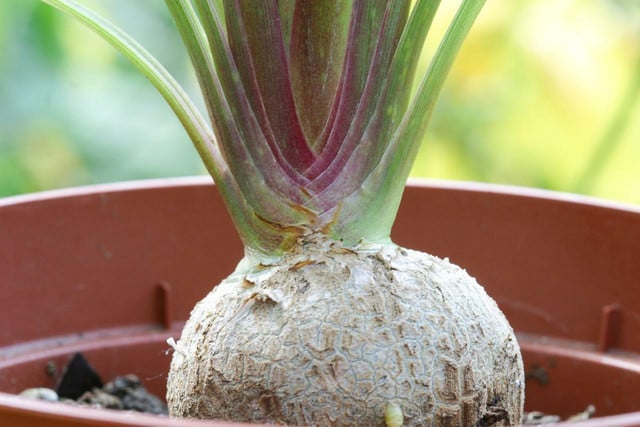


(Foto: CC0 / Pixabay / Olena758)
Whilst caring for your ponytail palm, you should keep an eye out for any unusual signs that something may be going awry. This can include the following changes:
- Yellowing leaves: Yellowing leaves are a telltale sign that your plant’s roots aren’t soaking up enough nutrients. The cause of this is usually excess watering, which consequently causes the roots to rot. Depending on the amount of root damage, you can try to repot the plant in dry soil. This should help nurse it back to full health.
- Brown tips on the leaves: Brown tips on the leaves of your ponytail palm can indicate underwatering or overfertilizing. It could also be a sign the plant is getting too much direct sunlight and not enough water, therefore you will need to adjust your plant care accordingly by watering it more or using less fertilizer.
It is also important that you don’t leave your plant too close to cold windows at night during winter, as this can harm your ponytail palm, and even severely damage it.
Is the Ponytail Palm a Sustainable Houseplant?



(Foto: CC0 / Pixabay / PollyDot)
The ponytail palm was once native to numerous states of eastern Mexico, however, it is now confined to the Mexican state of Veracruz. The state of Veracruz is home to a warm and humid climate, perfect for this houseplant.
If you choose to purchase one of these gorgeous houseplants, you can rest assured that you are choosing both a sustainable and bee-friendly option. Native bees are attracted to the flower spikes of the houseplant, so if your plant decides to flower, you could potentially be helping them out.
Bumble bees are important for sustainability as they help to pollinate plants, allowing them to grow and breed. This process is vital for much of our food production. It’s actually thanks to bees that we can eat foods such as apples, vanilla, broccoli, and almonds, alongside many more. According to Friends Of The Earth, over 90 percent of the worlds leading crop types are visited by bees, so it’s safe to say these little insects are really important.
If you want to make your ponytail palm even more sustainable, you could opt for an eco-friendly plant pot. Using sustainable, long-lasting, or recycled materials means you’ll be doing less environmental damage both in the short and long term.
Likewise, you can also help out the planet by opting not to use peat. Peat is an accumulation of partially decayed vegetation or organic matter that is very high in carbon, and the mining of the material is harming some of the largest carbon stores on our planet, so it’s not a very sustainable option overall. In addition, it contains very few nutrients and can take centuries to form — making it less sustainable. Instead, you could use coconut coir or compost, which are both more sustainable options. However, you should always check the most suitable option for your plant.
If you’re looking for some decorative house plants, indoor hanging plants are always a good place to start. Much like the ponytail palm, there are plenty of low-maintenance options to choose from.
Read more:
- Flamingo Flowers: Planting Tips and Care
- Repotting a Peace Lily: Why, When & How
- How to Take Care of Poinsettias This Winter
Do you like this post?






